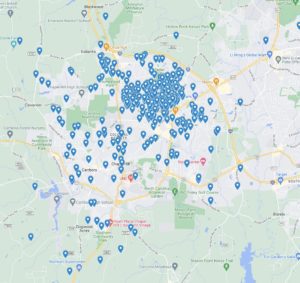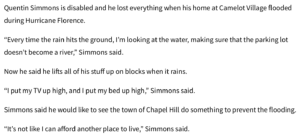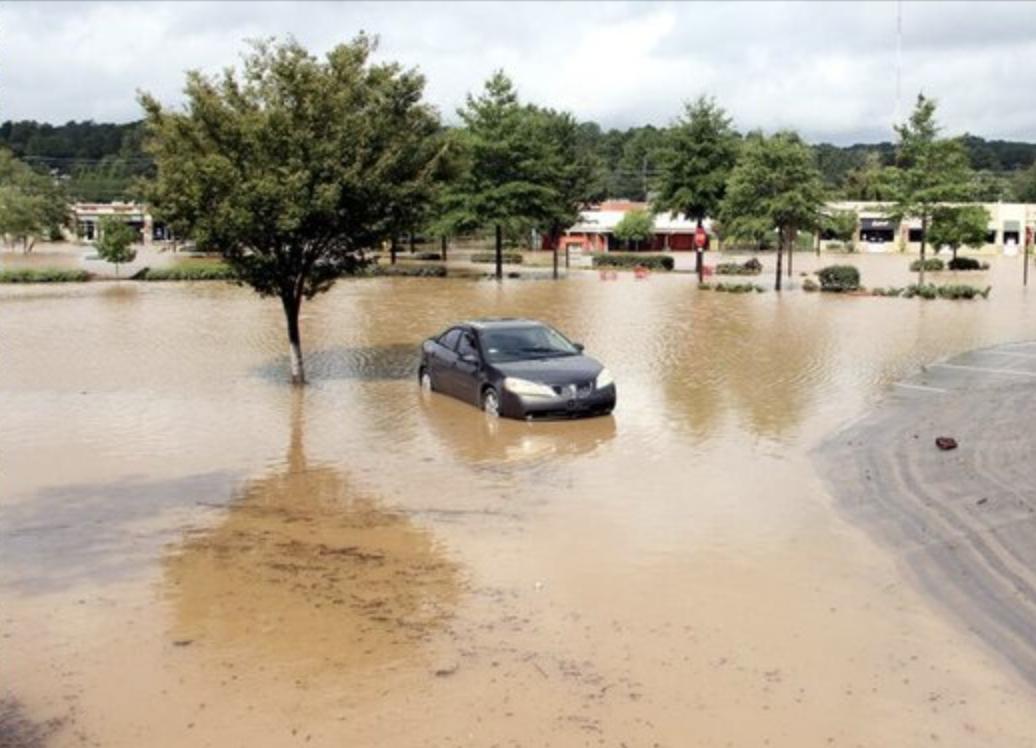This piece was written by Martin Johnson and Stephen Whitlow.
In a previous post, we discussed the Booker Creek Working Group, which the Town of Chapel Hill formed in response to neighbors’ opposition to stormwater management basins that would mitigate flooding in the Booker Creek watershed.
Town Council rescinded its approval of the storage basins soon after the newly formed Booker Creek Neighborhoods Preservation Alliance (“Alliance”) petitioned them to do so.
The response to our post in the darker corners of the internet (i.e., NextDoor) has been, shall we say, robust. Some accused the Blog Blog of making this a political issue.
But from the very beginning, there were politics involved.
In a December 21, 2021 video made by Duke students about the Alliance, John Morris — former director of Platform for CHALT and the Booker Creek Working Group co-chair — noted the politics inherent in this process:
“…it helped that there was an election approaching in Chapel Hill. … people around Piney Mountain Road just went crazy with opposition. And you know, they’re writing letters to the Council, putting up signs, petitions, etc. And so, [Mayor Hemminger], who’s a very skillful politician, said, ‘Whoa, this is not going to look good for me in election time.’ Who knows what she really thought but she had sufficient motives, just from political considerations. So she engineered a decision by the town council and this shows her skill. They basically disapproved the six [basins].”
We also heard on NextDoor that the petition and the formation of the working group had nothing to do with CHALT. We disagree (and will return to this topic in a future post).
We recognize that many opponents of the storage basins expressed genuine concern about potential changes to their neighborhoods. But CHALT leaders and members were also involved in the process — both in giving advice and in using their communications platforms to repeatedly share information about the Alliance. Given their track record of opposing almost all development in Chapel Hill – and that they tout themselves as “bring[ing] neighborhood concerns and constituent issues to the Town Council for evaluation and resolution” – it is important to note their involvement.
Why this working group should receive more attention
It’s important to scrutinize the Booker Creek Working Group, particularly because the Alliance came in at the 11th hour and, with CHALT’s help, halted a long, expensive, and public process that generated the set of recommended storage basins Council initially approved (a process, by the way, that CHALT leader Julie McClintock praised; the Stormwater Advisory Board on which McClintock served liked the WK Dickson study so much that it encouraged the Town to add it to the 2020 Comprehensive Plan).
Furthermore, all 61,000 residents who live here should have a say in decisions made about town-owned land (where most of the basins would have been located).
It is also important to recognize that stormwater management affects our town’s ability to grow. As noted by Rod Stevens, an expert hired by the town to examine our housing needs, Chapel Hill needs to build 500 housing units per year to keep pace with demand. Stormwater management solutions ideally prevent flooding of existing homes and businesses while enabling environmentally sound, dense development.
If we use stormwater as an excuse to become a no-growth town, we will simply push new Triangle residents to farther-flung areas, increase the region’s auto dependency, and do even worse damage to the environment than Chapel Hill’s love affair with cul-de-sacs and parking lots has already done.
The Blog Blog’s reaction to the Booker Creek Working Group’s draft recommendations
On September 13, the Booker Creek Working Group (BCWG) released a set of preliminary recommendations.
In response, we formed the Triangle Blog Blog Working Group to Analyze the Recommendations of the Booker Creek Working Group (TBBWGARBCWG).
With a skeptical eye, we watched as many of the working group’s twelve two-hour meetings as we could (sorry, but we do have day jobs!) and waded into their recommendations. Our initial reactions follow:
BCWG Recommendation 1: Advancement of green infrastructure
What does it involve? The Town of Chapel Hill would “provide technical assistance and cost share services to assist with green infrastructure installation on private property,” such as disconnecting downspouts, installing cisterns, and building rain gardens.
Will it stop flooding? Unclear. The working group is silent on the extent to which providing technical assistance and helping property owners (who are largely affluent in the Booker Creek watershed) pay for individual green improvements on their property will mitigate downstream flooding.
TBBWGARBCWG response: Green infrastructure is great and we encourage property owners to implement such improvements. Lowe’s is just up the road and they sell rain barrels!
We are skeptical that a voluntary program will move the needle on flooding, nor do we know how the Town will pay for “professional technical assistance” (also, a wealth of information is available online for free) or the proposed financial incentives.
According to the WK Dickson report, stormwater in the Booker Creek watershed behaves like a conservative’s fantasy, trickling down from well-off households on higher ground to lower-income households down below. To support an equitable approach, any incentives provided should be means-tested to ensure that lower-income households are able to participate and that renters in units at risk of flooding will benefit from the town’s investments. (Louie Rivers, who served on the working group as an expert on environmental justice, noted in one meeting that this recommendation would primarily benefit existing homeowners, and the effect on renters is less clear.)
Recommendation 2: Stream stabilization project
What does it involve? The Town would “provide private landowners with funding to repair and protect streambanks.”
Will it stop flooding? Maybe? The working group says “[when] properly designed, streambank stabilization increases the capacity of the stream by 25% to 35%.”
TBBWGARBCWG response: To be honest, none of us has ever had enough land to think “I’ve really got to stabilize my streambanks.” The BCWG recommendation does not explain what proper design involves, nor what length of streambank would need to be stabilized to increase stream capacity enough to reduce flooding.
According to the Dickson report, more than half of ten possible stream stabilization projects it identified could be hindered by their location near private property, homes, roads, or sewer easements. This raises doubts that a voluntary stream stabilization program for homeowners would achieve meaningful reductions in flooding.
Recommendation 3: Cost-Effective Flood Damage Reduction
What does it involve? It involves what sounds like a shit ton of time and money. It would identify “specific structures with flood risk, assigning a quantitative risk factor to each, evaluating a wide range of mitigation measures to determine which is most cost-effective in each particular case.” With analysis rivaling that required for a PhD, the Town would let you know if your shed might flood and what you might do about it.
Will it stop flooding? No. According to the working group, “the recommended new approach will shift the Town’s goal from preventing flooding to preventing flood damages.”
TBBWGARBCWG response: Think about how long it takes the Town of Chapel Hill to do anything, and how much you pay in taxes for that pleasure. Now think about how long it will take the Town and how much it will cost to “[evaluate] a wide range of damage mitigation measures … include property acquisition and demolition, property acquisition and relocation, elevation of structures, abandonment of basements, dry and wet floodproofing, small floodwalls to protect one or more structures, elevating HVAC equipment, and others” for each structure.
In the meantime, enjoy your flooding, I guess.
Recommendation 4: Preserving and protecting bottomland forests and natural stream corridors in Chapel Hill
What does it involve? The BCWG recommends “permanently protecting and expanding valuable bottomland forests and aquatic ecosystems in Chapel Hill,” which would involve placing conservation easements on existing town-owned land and purchasing land to expand protected areas. Additionally, the town would adopt “rules to limit development that would encroach on these areas.”
Will it stop flooding? No. This recommendation aims to ensure undeveloped land remains undeveloped.
TBBWGARBCWG response: This recommendation deserves close scrutiny for a number of reasons. First, the recommendation does not define nor map bottomland forests, nor identify town-land properties that would be rendered undevelopable by the scheme. Nor does the group identify other properties to purchase to expand protected areas or the cost to taxpayers of doing so. Finally, the working group does not describe what it would mean for development to “encroach” on protected areas.
While there is little information available to assess this recommendation, we are skeptical of its intent and wonder what effect its adoption would have on the vision for development on parts of the Greene Tract and American Legion, among other town-owned properties. We are also concerned that anti-development regulations attached to these properties could be so broad in scope as to eliminate not only the potential for housing on town-owned land, but across the entire watershed as well.
We are also concerned that the regulations would prevent paved greenways, which are a key component to building Complete Communities (Friends of Bolin Creek, which is led by CHALT leader Julie McClintock, opposes paved greenways along Bolin Creek).
Recommendation 5: Modification to the land use management ordinance (LUMO) to address the 100-year storm event in Chapel Hill
What does it involve? This recommendation is to update town ordinances that now address 25-year storm events to address 100-year events. The working group does not offer any specifics but wants to move quickly on this, noting that Town Council can implement this before updating our land use management ordinance.
Will it stop flooding? The devil is in the details but it would probably help keep things from getting worse. Presumably, any required stormwater measures that limit runoff from a 100- instead of 25-year storm event will decrease downstream flows. But this recommendation would only affect new development – not the existing, sprawling, car-oriented development that created the flooding problem.
TBBWGARBCWG response: Given climate change and the increasing frequency and intensity of storms, this is a reasonable recommendation for Council to consider. Currently, Council negotiates with developers on projects (like Aura) to implement 100-year stormwater mitigation controls, which adds time to the development process and costs that get passed onto residents. (At a recent planning commission meeting, the developer of 710 Estes indicated that increasing stormwater controls from the required 25 years to 100 years would increase project costs by a half million dollars, which would add roughly $10,000 to the cost of each unit over the span of a 30-year mortgage).
If – and this is the mother of all ifs – the town implements new stormwater regulations AND simultaneously a more streamlined development review process, the costs to developers (and future residents) for stormwater controls could potentially be offset by reduced costs to navigate the town’s byzantine and torturous development review process. Adding clarity and predictability for developers and better stormwater management is a win-win for the town.
It’s worth noting that new stormwater regulations are in effect a tax on future residents for the sins of the past. Much of the flooding we see today is a result of poor planning in previous decades, including our expansive road network to accommodate inefficient suburban sprawl in the Booker Creek watershed, and our love affair with plentiful parking. While this recommendation may be prudent because of climate change, it’s a shame that residents of today’s denser developments, which are far better for the environment, will be burdened with additional costs while residents of sprawling suburbs who drive everywhere will feel no pocketbook pain.
Recommendations 6-10
The working group has five other recommendations that we do not address in depth in this post. Generally speaking, they are consistent with the other recommendations in that they favor individual and voluntary responses rather than collective action, favor homeowners over renters, and establish additional processes that may stall or limit the development of multi-family housing in Chapel Hill.
Stormwater is a problem to solve, not just discuss
In May 2021, the Chapel Hill Town Council approved a plan five years in the making to address stormwater in the Booker Creek Watershed. In the blink of an eye, a small group of well-organized residents convinced the Town Council to abandon the plan, casting aside the work of the Town’s stormwater staff and its expert consultant (with experience with green infrastructure) for a volunteer working group.
We mapped the addresses of the petitioners who opposed the storage basins. It’s an impressive showing from across the Booker Creek watershed, as well as Carrboro, Durham, and Hillsborough.

Zooming in, however, we noticed a lack of petitioners in several low-lying spots, each of which is listed as areas of town most susceptible to flooding: Camelot Village, the Brookwood Condominiums, and the South Estes Drive public housing complex. Camelot flooded in 2013. And 2015. And 2018. And in 2020, after which one resident was interviewed for the local news:

Meanwhile, the Booker Creek Working Group’s work continues. According to the Town’s project page, the group will meet in October to finalize their recommendations to Town Council.
We encourage you to let Town Council know that you expect solutions soon to flooding that help our neighbors at the bottom of the hill, not just those at the top.

